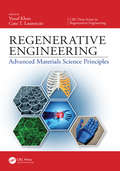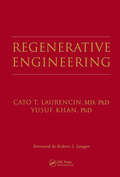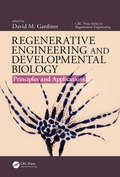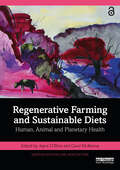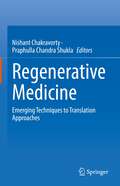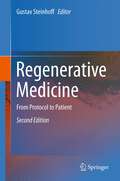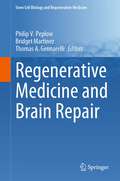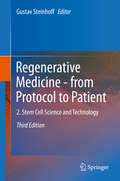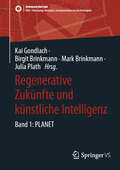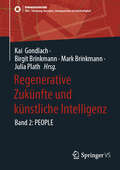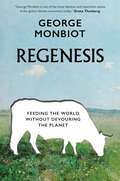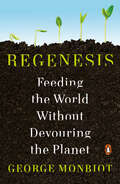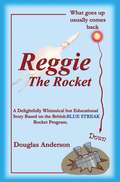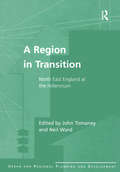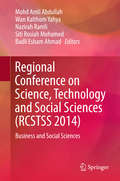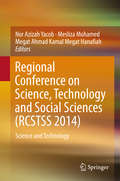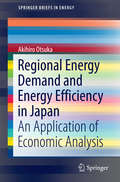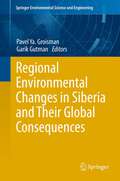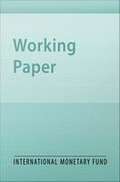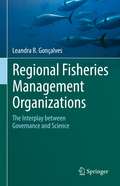- Table View
- List View
Regenerative Energietechnik: Überblick Über Ausgewählte Technologien Zur Nachhaltigen Energieversorgung
by Gerhard Reich Marcus ReppichDie Energiewirtschaft wird unter Berücksichtigung der Aspekte Versorgungssicherheit, Wirtschaftlichkeit sowie Klima- und Umweltschutz in den nächsten Jahrzehnten durch umfassende Veränderungen geprägt sein. Dieses Lehrbuch beschreibt Grundlagen ausgewählter Technologien zur Nutzung regenerativer Energiequellen, denen global langfristig das größte Potenzial eingeräumt wird. Den Schwerpunkt bildet die Umwandlung der Solarstrahlung und der Windenergie. Beide Technologien stellen unverzichtbare Bestandteile einer nachhaltigen Energieversorgung dar. Weiterhin werden die Erzeugung, die Speicherung und der Transport von Wasserstoff sowie Bauarten und Anwendungen von Brennstoffzellen erläutert. Beispielaufgaben und Übungen erleichtern und vertiefen das Verständnis.
Regenerative Engineering: Advanced Materials Science Principles (CRC Press Series In Regenerative Engineering)
by Yusuf Khan Cato T. LaurencinThis book focuses on advances made in both materials science and scaffold development techniques, paying close attention to the latest and state-of-the-art research. Chapters delve into a sweeping variety of specific materials categories, from composite materials to bioactive ceramics, exploring how these materials are specifically designed for regenerative engineering applications. Also included are unique chapters on biologically-derived scaffolding, along with 3D printing technology for regenerative engineering. Features: Covers the latest developments in advanced materials for regenerative engineering and medicine. Each chapter is written by world class researchers in various aspects of this medical technology. Provides unique coverage of biologically derived scaffolding. Includes separate chapter on how 3D printing technology is related to regenerative engineering. Includes extensive references at the end of each chapter to enhance further study.
Regenerative Engineering
by Cato T. Laurencin Yusuf KhanDistinct from tissue engineering, which focuses primarily on the repair of tissues, regenerative engineering focuses on the regeneration of tissues: creating living, functional tissue that has the ability to replace organs that are dysfunctional. The challenge of working in an area like regenerative engineering lies, in part, in the breadth of info
Regenerative Engineering and Developmental Biology: Principles and Applications (CRC Press Series In Regenerative Engineering)
by David M. GardinerRegenerative Engineering and Developmental Biology: Principles and Applications examines cutting-edge developments in the field of regenerative engineering. Specific attention is given to activities that embrace the importance of integrating developmental biology and tissue engineering, and how this can move beyond repairing damage to body parts to instead regenerate tissues and organs. The text furthermore focusses on the five legs of the field of regenerative engineering, including: materials, developmental biology, stem cells, physics, and clinical translation. This book was written by leading developmental biologists; each chapter examines the processes that these biologists study and how they can be advanced by using the tools available in tissue engineering/biomaterials. Individual chapters are complete with concluding remarks and thoughts on the future of regenerative engineering. A list of references is also provided to aid the reader with further research. Ultimately, this book achieves two goals. The first encourages the biomedical community to think about how inducing regeneration is an engineering problem. The second goal highlights the discoveries with animal regeneration and how these processes can be engineered to regenerate body parts. Regenerative Engineering and Developmental Biology: Principles and Applications was written with undergraduate and graduate-level biomedical engineering students and biomedical professionals in mind.
Regenerative Farming and Sustainable Diets: Human, Animal and Planetary Health (Earthscan Food and Agriculture)
by Joyce D’Silva Carol McKennaThis book makes the case for an urgent move away from industrial agriculture towards regenerative farming and the promotion of plant-based diets.How we produce, distribute and consume food are critical issues for the health and well-being of humans, animals and the environment. In order to develop a sustainable food system, this book argues for a radical change in farming and food consumption. Containing contributions from world renowned experts, this book promotes regenerative farming as the means to preserve planetary health, establish sustainable, healthy and secure diets and safeguard the welfare of animals. Chapters discuss broad ranging issues from climate change and biodiversity conservation to animal sentience and intensive farming, and the role of financial markets and food businesses. The book concludes with chapters discussing the routes in policy and practice to transforming the food system and achieving real-world change.This book is a must read for students, scholars and policymakers interested in establishing sustainable farming and food systems, for human health, animal welfare and environmental protection.The Open Access version of this book, available at www.taylorfrancis.com, has been made available under a Creative Commons Attribution‑Non Commercial‑No Derivatives (CC‑BY‑NC‑ND) 4.0 license.
Regenerative Medicine: Emerging Techniques to Translation Approaches
by Nishant Chakravorty Praphulla Chandra ShuklaThis book focuses on the recent innovations and therapeutic potentials of regenerative medicine and discusses the applications of stem cells, biomaterials, and tissue engineering in regenerative medicine. The book covers essential aspects of regenerative medicine, including tissue microenvironment, immunological perspectives, stem, and non-stem cell-mediated approaches, imaging techniques, biomarkers, and 3D printing technology. It also reviews the applications of biosensing technologies in regenerative medicine, including biomanufacturing, organ-on-a-chip technologies, and as indicators of therapeutic efficacy. Further, it focuses on the regenerative medicine approaches for diseases of the central nervous system. It also provides the therapeutic potential of regenerative medicine to improve soft tissue and wound healing, cardiovascular, neural, bone, and orofacial regeneration.
Regenerative Medicine
by Gustav SteinhoffRegenerative Medicine is a fastly emerging interdisciplinary field of research and clinical therapies on the repair, replacement or regeneration of cells, tissues or organs in congenital or acquired disease. This new field of research and clinical development focussing on stem cell science and regenerative biology is just starting to be the most fascinating and controversial medical development at the dawn of the 21st century. Viewing the great expectations to restructure and regenerate tissue, organs or organisms the current attempts of scientist and physicians are still in an early phase of development. This new textbook on "Regenerative Medicine - from protocol to patient" is aiming to explain the scientific knowledge and emerging technology as well as the clinical application in different organ systems and diseases. The international leading experts from four continents describe the latest scientific and clinical knowledge of the field of "Regenerative Medicine". The process of translating science of laboratory protocols into therapies is explained in sections on basic science, clinical translation, regulatory, ethical and industrial issues. The textbook is aiming to give the student, the researcher, the health care professional, the physician, and the patient a complete survey on the current scientific basis, therapeutical protocols, clinical translation and practised therapies in Regenerative Medicine.
Regenerative Medicine and Brain Repair (Stem Cell Biology and Regenerative Medicine #75)
by Philip V. Peplow Bridget Martinez Thomas A. GennarelliThis book presents the latest knowledge, trends, and advances in cell transplantation and innovations in developing microspheres, 3D biomaterial constructs to enhance transfer, and cell survival to specific regions of the brain. Neurodegenerative diseases and brain injury are increasing. Medications currently only temporarily reduce some of the symptoms but do not cure or delay progression of the disease. Development of effective treatments dramatically improves the independent living and quality of life of patients. Cell transplantation strategies offer an approach to facilitating brain repair, but efficacy is often limited by low in vivo survival rates of cells that are injected in suspension. Transplanting cells that are attached to or encapsulated within a biomaterial construct has the advantage of maintaining cell-cell and cell-material interactions and improving cell survival in vivo. Biomaterials that have been used in preclinical studies to assist with in vivo cell transfer and survival include heparin-chitosan microspheres, poly(lactic-co-glycolic acid) microspheres, RADA 16 microspheres, poly(desaminotyrosyl tyrosine ethyl ester carbonate) microscale scaffolds, carbon nanotubes, collagen-chitosan scaffolds, poly(L-lactic acid) scaffolds, agarose hydrogels, gelatin methacrylate hydrogels, and agarose micro-columns with an extracellular matrix interior. Incorporating growth factors (e.g., glial-derived neurotrophic factor, neurotrophin 3) into the biomaterial constructs increased cell survival and incorporation into the host tissue. International experts in the fields of both experimental and clinical neurological research contribute chapters to this book and discuss the latest achievements in cell transplantation and matrix-assisted cell transfer/survival technologies for diseases such as Alzheimer’s disease, Parkinson’s disease, and brain injuries such as stroke and traumatic brain injury. It is envisaged that research findings in experimental animal models of Alzheimer’s disease, Parkinson’s disease, traumatic brain injury, and stroke promote clinical trials using biomaterial-assisted transfer of cells.
Regenerative Medicine and Stem Cell Biology: Bench To Bedside (Learning Materials in Biosciences #0)
by Nagwa El-BadriThis textbook covers the basic aspects of stem cell research and applications in regenerative medicine. Each chapter includes a didactic component and a practical section. The book offers readers insights into: How to identify the basic concepts of stem cell biology and the molecular regulation of pluripotency and stem cell development. How to produce induced pluripotent stem cells (iPSCs) and the basics of transfection. The biology of adult stem cells, with particular emphasis on mesenchymal stromal cells and hematopoietic stem cells, and the basic mechanisms that regulate them. How cancer stem cells arise and metastasize, and their properties. How to develop the skills needed to isolate, differentiate and characterize adult stem The clinical significance of stem cell research and the potential problems that need to be overcome. Evaluating the use of stem cells for tissue engineering and therapies (the amniotic membrane) The applications of bio-nanotechnology in stem cell research. How epigenetic mechanisms, including various DNA modifications and histone dynamics, are involved in regulating the potentiality and differentiation of stem cells. The scientific methods, ethical considerations and implications of stem cell research.
Regenerative Medicine - from Protocol to Patient
by Gustav SteinhoffRegenerative medicine is the main field of groundbreaking medical development and therapy using knowledge from developmental and stem cell biology as well as advanced molecular and cellular techniques. This collection of volumes, Regenerative Medicine: From Protocol to Patient, aims to explain the scientific knowledge and emerging technology as well as the clinical application in different organ systems and diseases. International leading experts from all over the world describe the latest scientific and clinical knowledge of the field of regenerative medicine. The process of translating science of laboratory protocols into therapies is explained in sections on regulatory, ethical and industrial issues. The collection is organized into five volumes: (1) Biology of Tissue Regeneration, (2) Stem Cell Science and Technology, (3) Tissue Engineering, Biomaterials and Nanotechnology, (4) Regenerative Therapies I, and (5) Regenerative Therapies II. The textbook gives the student, the researcher, the health care professional, the physician and the patient a complete survey on the current scientific basis, therapeutical protocols, clinical translation and practiced therapies in regenerative medicine. Volume 3: Tissue engineering, Biomaterials and Nanotechnology focuses the development of technologies, which enable an efficient transfer of therapeutic genes and drugs exclusively to target cells and potential bioactive materials for clinical use. Principles of tissue engineering, vector technology, multifunctionalized nanoparticles, biodegradable materials, controlled release, and biointerface technology are described with regard to the development of new clinical cell technology. Imaging and targeting technologies as well as biological aspects of tissue and organ engineering are depicted.
Regenerative Zukünfte und künstliche Intelligenz: Band 1: PLANET (SDG - Forschung, Konzepte, Lösungsansätze zur Nachhaltigkeit)
by Kai Gondlach Birgit Brinkmann Mark Brinkmann Julia PlathDieses Buchprojekt erscheint in drei Teilen mit jeweils einem inhaltlichen Schwerpunkt – PLANET, PEOPLE, PROFIT – und beschäftigt sich übergreifend mit den Nachhaltigkeitszielen der Vereinten Nationen (Sustainable Development Goals, SDGs). Dieser erste Band behandelt die ökologische Dimension der Nachhaltigkeit und umfasst Beiträge, die explizit oder implizit SDGs mit Umweltbezug thematisieren. Die Beiträge und Grußworte international renommierter Expert:innen aus Wissenschaft und Praxis werden durch Begleittexte der Herausgebenden ergänzt. „Wir wissen genug, wir können genug. Wir müssen uns jetzt trauen, den richtigen Weg einzuschlagen“, aus dem Grußwort von Prof. Dr. Johan Rockström, Potsdam-Institut für Klimafolgenforschung.
Regenerative Zukünfte und künstliche Intelligenz: Band 2: PEOPLE (SDG - Forschung, Konzepte, Lösungsansätze zur Nachhaltigkeit)
by Kai Gondlach Birgit Brinkmann Mark Brinkmann Julia PlathDer Band basiert auf den 17 Entwicklungszielen (SDGs) der UNO und entwickelt für die Wirtschaft Zukunftsperspektiven zum Zusammenhang von KI und Nachhaltigkeit.
Regenesis: Feeding the World Without Devouring the Planet
by George Monbiot* GEORGE MONBIOT IS THE WINNER OF THE 2022 ORWELL PRIZE FOR JOURNALISM *What if there were a way to stop climate change and end global hunger at the same time?The way we feed ourselves is destroying the planet, and a collection of crises have brought the global food supply to its breaking point. But it doesn't have to be this way. With technology that already exists, we could sustainably provide everyone on the planet with a healthy diet. By cultivating hydrogen-eating bacteria, deep-rooted plants, and much richer communities of insects--coupled with existing technology to reduce our dependence on meat--we can dramatically reduce our carbon footprint, solve world hunger, and halt the sixth extinction at the same time.George Monbiot is an internationally renowned climate activist, widely known for bringing bold, creative thinking to the climate and ecological crises facing our planet. Now, he turns his attention to the global food system to offer a reimagining of the way we feed ourselves on a scale to fit the urgency of the problems we face.
Regenesis: Feeding the World Without Devouring the Planet
by George Monbiot&“This remarkable book, staring curiously down at the soil beneath our feet, points us convincingly in one of the directions we must travel. I learned something on every page.&” —Bill McKibbenFor the first time since the Neolithic, we have the opportunity to transform not only our food system but our entire relationship to the living world. Farming is the world's greatest cause of environmental destruction – and the one we are least prepared to talk about. We criticise urban sprawl, but farming sprawls across thirty times as much land. We have ploughed, fenced and grazed great tracts of the planet, felling forests, killing wildlife, and poisoning rivers and oceans to feed ourselves. Yet millions still go hungry. Now the food system itself is beginning to falter. But, as George Monbiot shows us in this brilliant, bracingly original new book, we can resolve the biggest of our dilemmas and feed the world without devouring the planet. Regenesis is a breathtaking vision of a new future for food and for humanity. Drawing on astonishing advances in soil ecology, Monbiot reveals how our changing understanding of the world beneath our feet could allow us to grow more food with less farming. He meets the people who are unlocking these methods, from the fruit and vegetable grower revolutionising our understanding of fertility; through breeders of perennial grains, liberating the land from ploughs and poisons; to the scientists pioneering new ways to grow protein and fat. Together, they show how the tiniest life forms could help us make peace with the planet, restore its living systems, and replace the age of extinction with an age of regenesis.
Reggie The Rocket: What Goes Up Usually Comes Back Down
by Douglas AndersonThe story of Reggie The Rocket closely tracks the history of the 1960s British Blue Streak rocket program. The author Douglas Anderson worked on the assembly and testing of the Rolls-Royce RZ2 engines powering the Blue Streak and was present in Woomera, Australia, for the launch of F3. Based on that experience, Douglas has assigned a personality to the rockets and has thus woven a whimsical element into an otherwise historical account of the Blue Streak Program. Reggie The Rocket is F3, the third in line to be launched, and Douglas was there to cheer him on. It is a sad reality that most heavy-lift booster rockets have been launched only to return to earth as scrap metal or to have disappeared into the ocean depths. Only now, fifty years after Blue Streak, are serious attempts being made to return booster rockets safely back to the launch pad under their own power so they can be reused. The days of 'throw away' rockets must surely come to an end if humans are to continue with orbital flights and deep space exploration.
A Region in Transition: North East England at the Millennium (Urban and Regional Planning and Development Series)
by John Tomaney Neil WardThe UK has now joined a Europe-wide trend towards more devolved forms of government (e.g. Scotland, Wales and Northern Ireland Assemblies). In the context of this general trend towards regionalizm as a focus for public policy and as a source of cultural and political identity, an interdisciplinary team from Newcastle University combine to analyze how this affects the North East of England. There has been comparatively little published on the contemporary development of English Regions and the North East is a particularly important case study, as throughout the 1990s it has experienced a range of social, economic and political changes. This book will contribute to key contemporary policy debates, which will affect all of the English regions and should be read by all social scientists interested in European regional development.
Regional Advantage
by Annalee SaxenianLike the Greeks who sailed with Jason in search of the Golden Fleece, the new Argonauts--foreign-born, technically skilled entrepreneurs who travel back and forth between Silicon Valley and their home countries--seek their fortune in distant lands by launching companies far from established centers of skill and technology. Their story illuminates profound transformations in the global economy. Economic geographer AnnaLee Saxenian has followed this transformation, exploring one of its great paradoxes: how the "brain drain" has become "brain circulation," a powerful economic force for development of formerly peripheral regions. The new Argonauts--armed with Silicon Valley experience and relationships and the ability to operate in two countries simultaneously--quickly identify market opportunities, locate foreign partners, and manage cross-border business operations. The New Argonauts extends Saxenian's pioneering research into the dynamics of competition in Silicon Valley. The book brings a fresh perspective to the way that technology entrepreneurs build regional advantage in order to compete in global markets. Scholars, policymakers, and business leaders will benefit from Saxenian's firsthand research into the investors and entrepreneurs who return home to start new companies while remaining tied to powerful economic and professional communities in the United States. For Americans accustomed to unchallenged economic domination, the fast-growing capabilities of China and India may seem threatening. But as Saxenian convincingly displays in this pathbreaking book, the Argonauts have made America richer, not poorer.
Regional Approaches to the Energy Transition: A Multidisciplinary Perspective
by Katarzyna Gromek-BrocThe book"Regional Approaches to the Energy Transition", discusses the key challenges the energy transition is facing at the European and International level. It is an edited collection gathering contributions from the experts in the field bringing together internationally renowned scholars, researchers, EU officials to address the current trends in the energy transition and its dilemmas.The book places the energy transition in a wide interdisciplinary context. It looks at energy policies, legal framework, regional strategies and the difficulties in their implementation. It argues for a regional approach to the energy transition, questioning at the same time the strategies and measures put forward for its realisation. The subject matter is topical, considering recent themes that occupy global and European political agendas.In a nutshell, the volume offers insights into regional regulations, public policies and local practices on the use of clean energy. It looks first at the EU commitment and its initiatives providing some examples from the Member States. Furthermore, it offers a comparative perspective and discusses the different approaches to the energy transition from Latin America, China, Africa and Australia. It covers a wide range of topics such as the EU renewable energy policies, Green Deal and regionalisation, energy auctions in the EU, environment in contemporary constitutionalism, Human Rights considerations, the Scandinavian perspective, practical examples from Italy and Spain. Moreover, it also considers the global context, looking at State and Market in China's coal-to-gas transition, tendencies of legal regulation in the sphere of renewable energy in Russia, the energy transition in Latin-American countries, regional approach to the energy transition and electricity access initiatives in Sub-Saharan Africa, and transnationalism and the regional approach to the energy transition in Australia. The systematisation that this book offers and the exchange of good practices and experiences are useful tools for the key players to seriously engage with a just and sustainable energy transition. The proposed book is a reference and study material for academics and students, but also for the policy makers, officials and practitioners dealing with the energy transition. It provides some answers, potential solutions and alternatives to the main problems that the energy sector is facing worldwide.
Regional Conference on Science, Technology and Social Sciences (RCSTSS #2014)
by Mohd Amli Abdullah Wan Kalthom Yahya Nazirah Ramli Siti Rosiah Mohamed Badli Esham AhmadThis book features more than 95 papers that were presented at the bi-annual Regional Conference on Science, Technology and Social Sciences, RCSTSS 2014, which was organized by Universiti Teknologi MARA Pahang. It covers topics ranging from communications studies, politics, psychology, education, religious studies as well as business and economics. The papers, which have been carefully reviewed, include research conducted by academicians locally, regionally and globally. They detail invaluable insights on the important roles played by the various disciplines in science, technology and social sciences. Coverage includes accounting, art and design, business, communication, economics, education, finance, humanity, information management, marketing, music, religion, social sciences and tourism. Throughout, clear illustrations, figures and diagrams complement the research. The book is a significant point of reference to academicians and students who want to pursue further research in their respective fields. It also serves as a platform to disseminate research findings as a catalyst to bring out positive innovations on the development of the region.
Regional Conference on Science, Technology and Social Sciences: Theoretical And Applied Sciences (RCSTSS #2016)
by Shaikh Abdul Karim Yamani Zakaria Rahmah Lob Yussof Nor Yuziah Mohd Yunus Nur Asmaliza Mohd Noor Nor Azizah YacobThis book gathers selected theoretical and applied science papers presented at the 2016 Regional Conference of Sciences, Technology and Social Sciences (RCSTSS 2016), organized biannually by the Universiti Teknologi MARA Pahang, Malaysia. Addressing a broad range of topics, including architecture, computer science, engineering, environmental and management, furniture, forestry, health and medicine, material science, mathematics, plantation and agrotechnology, sports science and statistics, the book serves as an essential platform for disseminating research findings, and inspires positive innovations in the region’s development.The carefully reviewed papers in this volume present work by researchers of local, regional and global prominence. Taken together, they offer a valuable reference guide and point of departure for all academics and students who want to pursue further research in their respective fields.
Regional Conference on Science, Technology and Social Sciences (RCSTSS #2014)
by Nor Azizah Yacob Mesliza Mohamed Megat Ahmad Kamal Megat HanafiahThis book gathers selected science and technology papers that were presented at the 2014 Regional Conference of Sciences, Technology and Social Sciences (RCSTSS 2014). The bi-annual Conference is organized by Universiti Teknologi MARA Pahang, Maylasia. The papers address a broad range of topics including architecture, life sciences, robotics, sustainable development, engineering, food science and mathematics. The book serves as a platform for disseminating research findings, as a catalyst to inspire positive innovations in the development of the region. The carefully-reviewed papers in this volume present research by academicians of local, regional and global prominence. Out of more than 200 manuscripts presented at the conference by researchers from local and foreign universities and institutions of higher learning, 64 papers were chosen for inclusion in this publication. The papers are organized in more than a dozen broad categories, spanning the range of scientific research: * Engineering * Robotics * Mathematics & Statistics * Computer & Information Technology * Forestry * Plantation & Agrotechnology * Sports Science & Recreation * Health & Medicine * Biology * Physics * Food Science * Environment Science & Management * Sustainable Development * Architecture The book provides a significant point of reference for academics, researchers and students in many fields who need deeper research.
Regional Energy Demand and Energy Efficiency in Japan
by Akihiro OtsukaThis book describes structural analysis methods for examining energy demand and energy efficiency that are important in formulating regional economic and environmental policies. Beginning with ways of ascertaining regional energy demand, it describes methods for developing energy efficiency indicators and their determinants. Fluctuations in regional energy demand are largely explained by analyzing variations in energy intensity, and there is a strong association between energy efficiency indicators and energy intensity. The energy efficiency indicator proposed is consistent with fluctuations in energy intensity and is highly accurate. According to the empirical analysis using this indicator, energy efficiency is high in regions where population concentration has risen, as typified by "compact cities. " As such, the book highlights the need to increase regional energy efficiency, to achieve regional economic growth despite growing environmental constraints, and the importance of forming and developing clusters to this end. The book is a valuable resource for planners, researchers and government employees.
Regional Environmental Changes in Siberia and Their Global Consequences
by Garik Gutman Pavel Ya. GroismanThis volume presents a state-of-the-art assessment of the Earth's climate system in Siberia and relationships between climate, ecosystems and people in that region. Changes in climatic variables and land cover in Siberia are among the earliest indicators of the Earth's response to climate warming. The volume is a compilation of results from studies on climate, land-cover and land-use changes and their interactions with biogeochemical and water cycles, atmospheric aerosol, and human and wildlife populations in Siberia. Regional changes in Siberia are predicted to affect climate and people on a global scale. NASA, the Russian Academy of Sciences, and several European institutions have supported these studies. The primary supporter of the projects that produced the results compiled in this volume is the NASA Land-Cover/Land-Use Change Program, hence most studies use remote sensing in their research. The chapters in this volume were written by an international team of scientists from the USA, Europe and Russia under the auspices of the Northern Eurasia Earth Science Partnership Initiative (NEESPI). This book will be of interest to those involved in studying recent and ongoing changes in Siberia, be they senior scientists, early career scientists or students.
Regional Financial Integration in the GCC
by Raphael Espinoza Ananthakrishnan Prasad Oral WilliamsA report from the International Monetary Fund.
Regional Fisheries Management Organizations: The interplay between governance and science
by Leandra R. GonçalvesThis book analyzes empirical data from three specific Regional Fisheries Management Organizations (RFMOs) designed to establish rules for the conservation and management of fish stocks in the ocean, in order to assess their effectiveness in converting science into policy for the recovery and maintenance of fishery populations. The three RFMOs discussed are the CCAMLR (Convention for the Conservation of Antarctic Marine Living Resources), the ICCAT (International Commission for the Conservation of Atlantic Tunas) and the CCSBT (Commission for the Conservation of Southern Bluefin Tuna). The book seeks to understand when governments choose to listen to science, and establishes a framework to examine the institutional designs currently in place to accommodate RFMO policy suggestions and the conditions under which they are implemented successfully. The study will be of interest to academics and professionals broadly interested in global environmental governance and international relations, and will specifically appeal to policymakers, conservationists, and environmental researchers interested in fishery management and policy at the global and regional scale. Gonçalves provides an accessible and comprehensive analysis of RMFOs. She offers valuable insights into the role of science and politics in shaping sustainable fisheries policies for the open oceans. ---Peter M Haas, Professor Department of Political Science, University of Massachusetts AmherstAs envisaged by the UN Decade of Ocean proclamation, this book is an important and sincere effort, hopefully to be accompanied by many others to come during this promising decade, that will help to build a common framework to ensure that ocean science can support countries and the international community in creating improved conditions for the sustainable development of our cherished Ocean.---Fabio H. Hazin - Professor at Federal Rural University of Pernambuco, Brazil

